UK’s biggest ever dinosaur footprint trackways unearthed
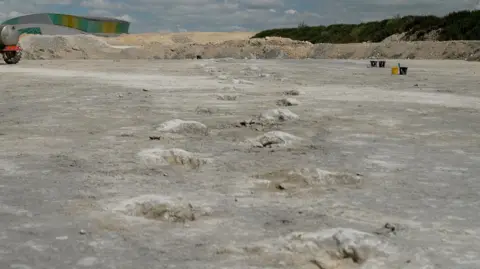 BBC/Kevin Church
BBC/Kevin ChurchThe largest dinosaur footprint ever found in the UK has been discovered in an Oxfordshire quarry.
About 200 giant footprints formed 166 million years ago crisscross the limestone floor.
They reveal the comings and goings of two different types of dinosaurs, thought to be a long-necked sauropod called Cetiosaurus and the smaller carnivorous Megalosaurus.
The longest track is 150m long, but as only part of the quarry has been excavated, the track can be extended further.
Professor Kirsty Edgar, a micropalaeontologist at the University of Birmingham, said: “This is one of the most impressive footprints I have ever seen, both in terms of scale and the size of the footprint.”
“You can go back in time and imagine what it would have been like to have these huge creatures just wandering around, minding their own business.”
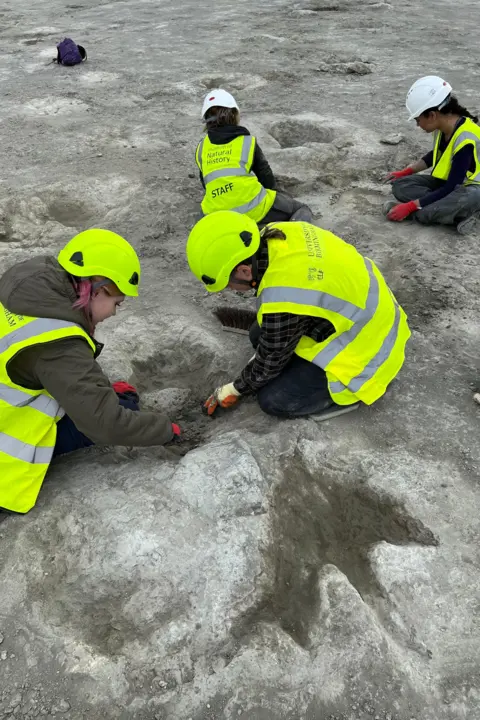 Richard Butler/University of Birmingham
Richard Butler/University of BirminghamThe traces were first discovered by Gary Johnson, a worker at the Duvas Farm quarry while driving an excavator.
“I was basically clearing the clay and I hit a bulge, which I thought was just an anomaly in the ground,” he said, pointing to a ridge where some dirt had been pushed up when the dinosaur’s feet pressed into the earth.
“But then it extended another 3m and another hump appeared. Then it extended another 3m and another hump appeared.”
In the 1990s, another track was discovered nearby, so he realized the regular undulations might be dinosaur tracks.
“I thought I was the first person to see them. It was so surreal – it really stung a bit,” he told BBC News.
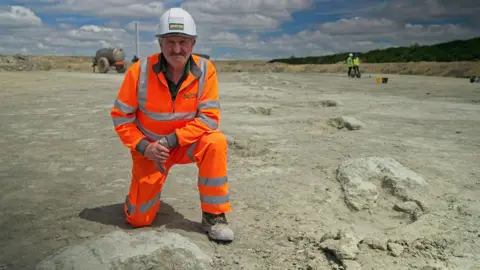 BBC/Kevin Church
BBC/Kevin ChurchThis summer, more than 100 scientists, students and volunteers took part in an excavation at the quarry, which is featured in the new series Digging for Britain.
The team discovered five distinct tracks.
Four of them were made from sauropods, plant-eating dinosaurs that walked on four legs. Their tracks look a bit like elephants – just much larger – and these beasts can reach lengths of up to 18m.
Another track is thought to have been created by Megalosaurus.
“It’s almost like a caricature of a dinosaur track,” explains Dr. Emma Nicholls, a vertebrate paleontologist at the University of Oxford’s Museum of Natural History.
“This is what we call a three-toed print. Its three toes are very, very clear in the print.”
The two-legged predators were agile hunters, she said.
“The whole animal was 6-9m long. They are the largest predatory dinosaurs we know of from the British Jurassic period.”
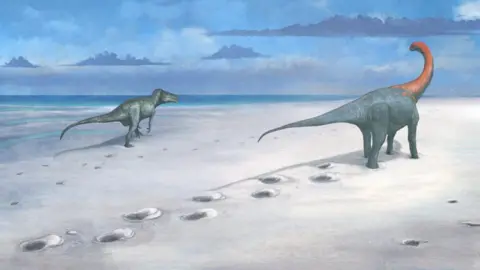 Mark Wetton
Mark WettonTheir environment was covered in warm, shallow lagoons, and dinosaurs left footprints as they wandered through the mud.
Professor Richard Butler, a paleontologist at the University of Birmingham, said: “Something must have happened to preserve these fossils in the fossil record.”
“We don’t know exactly what it was, but there could have been a storm event that deposited a lot of sediment on the footprints, meaning they were preserved rather than washed away.”
The team studied the tracks in detail during the excavation. In addition to modeling the footprints, they took more than 20,000 photos to create 3D models of the entire site and individual footprints.
Professor Butler explained: “The really lovely thing about dinosaur tracks is that they are a snapshot of an animal’s life, especially if there are tracks.”
“You can understand how the animal moved. You can understand exactly what the environment it lived in was like. So the tracks give us a completely different set of information that you can’t get from the skeletal fossil record of.”
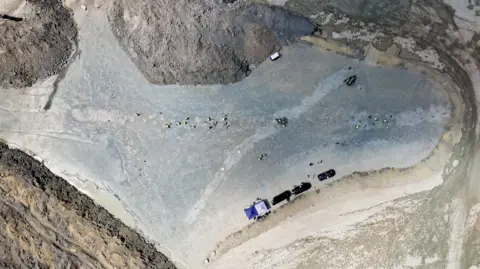 BBC/Kevin Church
BBC/Kevin Church BBC/Kevin Church
BBC/Kevin Church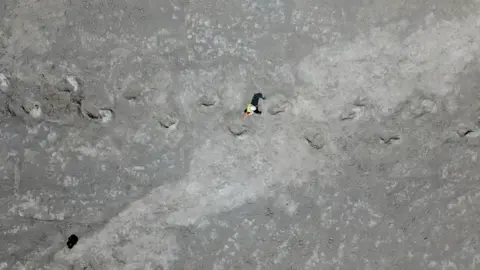 BBC/Kevin Church
BBC/Kevin ChurchOne area of the site even reveals the paths that sauropods and titanosaurs once crossed.
The footprints are so beautifully preserved that the team has been able to figure out which animal crossed first – they believe it was a sauropod, because the leading edges of its large, rounded footprints were broken by three-toed animals that walked on them. The dragon squished slightly. its top.
Dr Duncan Murdoch of the University of Oxford said: “It is exciting to know that this dinosaur once walked across this surface and left accurate footprints.”
“You can imagine it pulling its legs out of the mud as it goes forward.”
The future fate of the tracks has yet to be determined, but scientists are working with the quarry’s operators Smiths Bletchington and Natural England to examine options for protecting the site in the future.
They believe there may be more footprints, echoes from our prehistoric past, just waiting to be discovered.
The excavation will be featured on BBC Radio 2’s Digging for Britain program at 20:00 on Wednesday 8 January. The full series will be available to stream on BBC iPlayer on 7 January.



